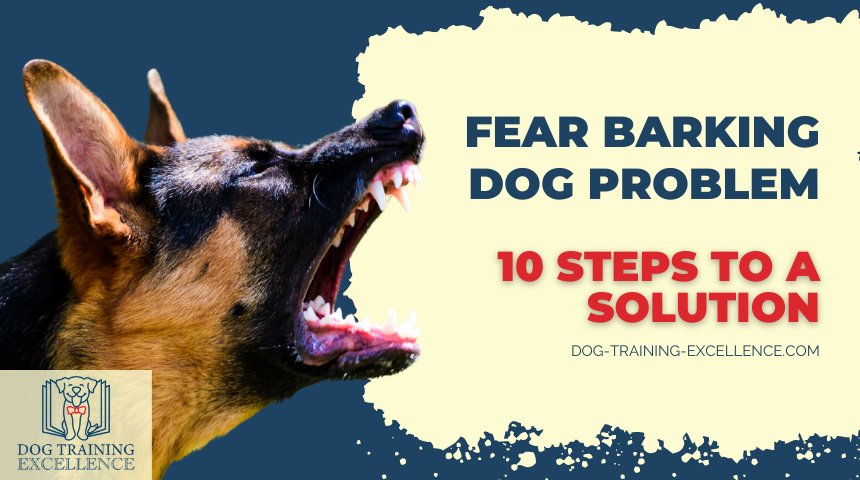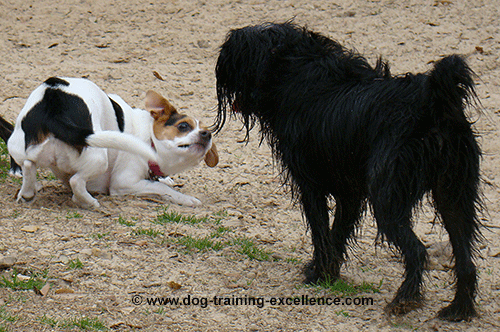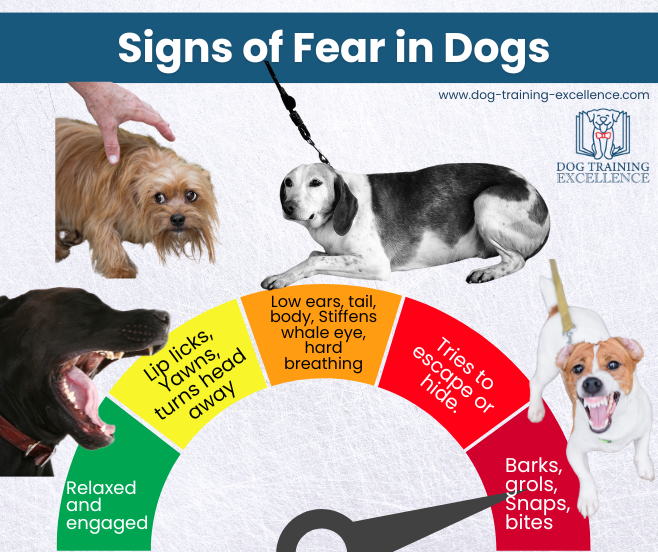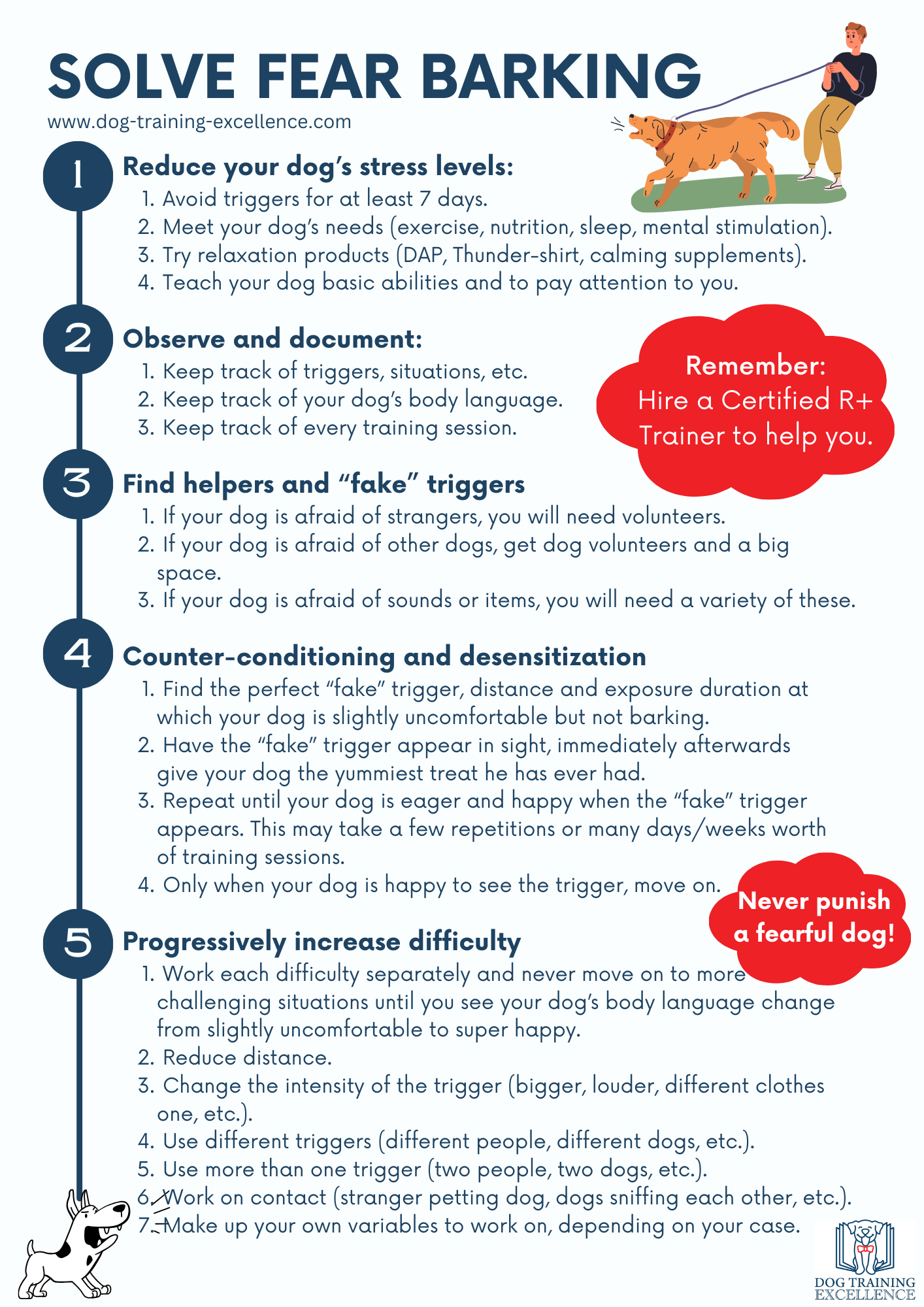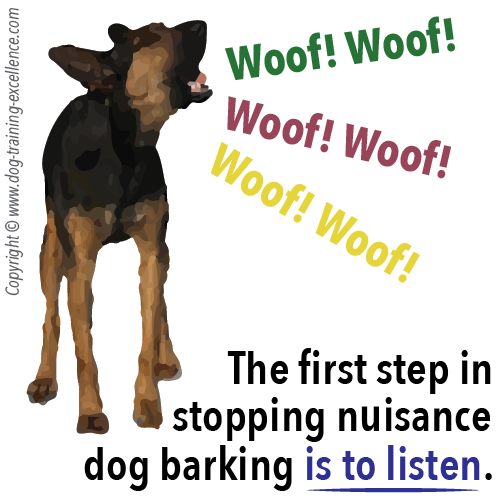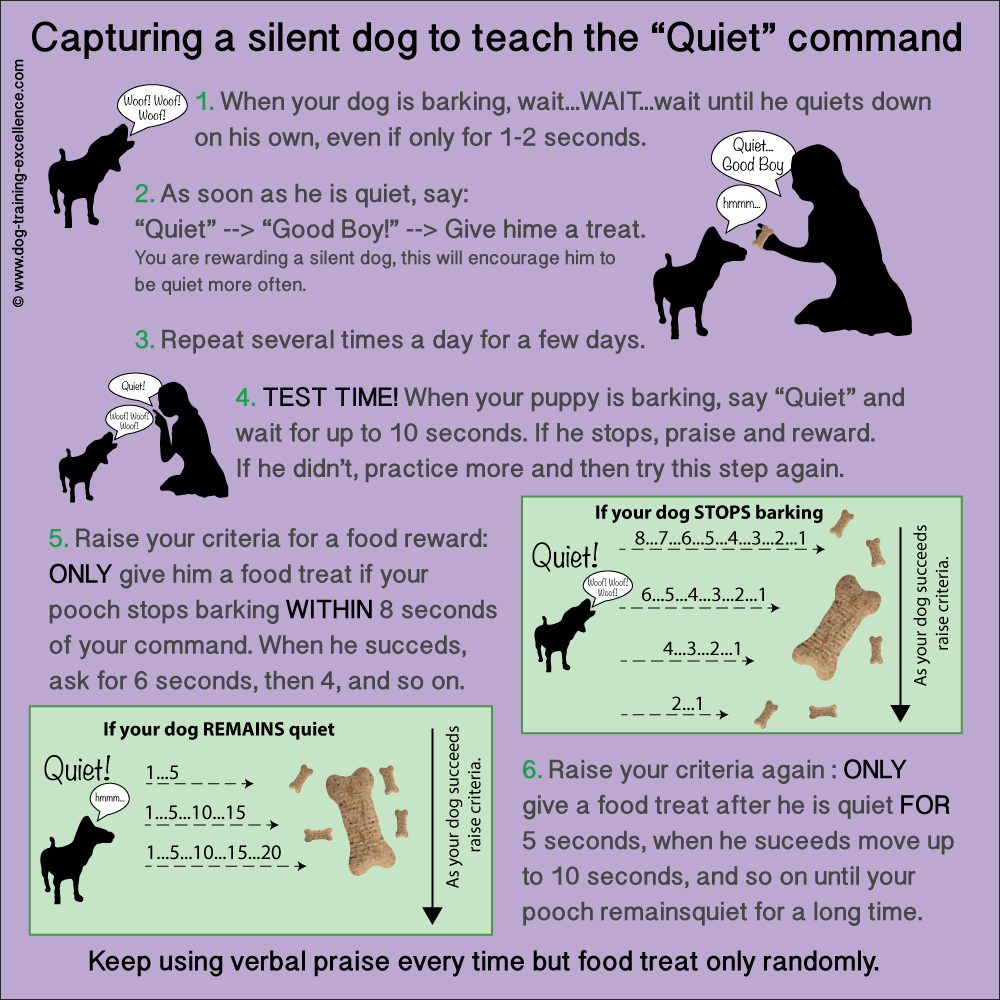I try to write my posts as unbiased as possible and recommend the products I consider to be useful and the best. I use affiliate links, this means that–at no extra cost to you–I can make a commission on a purchase you make after clicking on them. As an Amazon Associate I earn from qualifying purchases.
Fear Barking Dog Problem:
10 Steps to a Solution
Do you have a fear barking dog problem? Does your dog show aggressive behaviors like barking? Are you feeling frustrated and scared? Can you stop a dog from barking? Don't worry; you're not alone.
Fear barking can be quite a challenge,
but with the right approach, patience, and a sprinkle of love, you can
help your pup overcome this obstacle. As a Certified Professional Dog Trainer
specializing in reward-based and evidence-based methods, I'm here to
guide you through the process with 10 actionable steps to put a stop to
that fear barking once and for all. For your sake and your dog's well-being.
What you will learn:
- Understanding Fear and Stress In Your Dog
- Step 1: Decrease your Dog's Stress Levels
- Signs of Fear in Dogs
- Should I Punish My Dog for Fear Barking?
- Two Methods for Solving a Fear Barking Dog Problem
- (10 Steps) Step-by-step Treatment for Fear Barking
- Tips to Solve a Fear Barking Dog Problem
- Best Dog Books For Reactive Dogs
- Frequently Asked Questions About Fear Barking
- Solve a Fear Barking Dog Problem and Enjoy Your Dog
Understanding fear and stress in your dog
What is fear barking all about? A fear barking dog problem usually stems from anxiety or insecurity in dogs. It's their way of expressing discomfort or fear in certain situations. Why your dog is terrified of a certain thing (or everything) depends on each case. Some dogs have a genetic predisposition to be fearful and early experiences made them fearful. Other dogs missed the opportunity to socialize correctly and don't know what is safe and what isn't (that's what we are going to teach them!).
Almost all dogs are afraid of something and most of the time this is not a problem because it does not show very often. If
you are reading this it's probably because your dog is afraid of things
that he encounters daily and barking is his way of dealing with it. Your goal: to teach your dog to feel secure and find safety in you when needed.
Animals have 3 biological mechanisms to deal with threats:
- Fight: It may start with a mild aggressive dog behavior like barking and escalate to growling, snapping and biting. This option could get one or both parties involved injured!
- Flight: The dog will try to escape and put as much distance as possible between him and the scary subject/object.
- Freeze: The hound will stay as still as possible (maybe that threatening thing won't see me!).
The majority of dogs do not like to get into fights, this is a dangerous thing to do, flight is much safer. But if they are in a situation in which they can't escape (for example, on a leash), they will go into "fight" mode. Fight mode starts with barking. This usually is all it takes to scare a person or another animal away. Now your hound has learned that barking keeps him safe, he will continue doing so and you have a barking dog problem!
Even if your dog has an escape route, he may not realize it and feel cornered. That is also why teaching your dog to look for safety in you, to search for escape routes is a great way to prevent getting him into fight mode.
Chronic Stress In Your Reactive Dog
Another important aspect of fear aggression in dogs is STRESS. When your dog is in fear, stress hormones (like glucocorticoids) are released in his body. The purpose of these hormones is to keep the animal alert for the next 2-7 days in case a similar scary situation happens (then the reaction is even faster!).
The problem with stress hormones is that they can accumulate every time your dog faces a threatening situation. The more they accumulate the jumpier your hound gets.
So, if your dog is afraid of other dogs and you take him to the park every day…guess what? He probably has chronic stress. This is emotionally exhausting and harming. Stress also decreases learning, so your pooch is not in an open frame of mind to hear what you want to teach him to solve this barking dog problem.
In my almost 20 years of experience working with fearful dogs, almost all of them suffer from chronic stress.
How to solve this? You are in control of your pet's life. Make a big difference in his routine.
Step 1: Decrease your Dog's Stress Levels
Below you will learn about 3 ways in which you can help your dog relax. You do not have to change everything at once, pick one or two of the suggestions below to start with. Pick the ones that best fit your schedule or you think are working better for you and your pooch. Start using the following techniques at least a week before you start training. It will help your dog focus on what you will teach him instead of being afraid. Keep doing them until you start seeing some good progress with training.
Professional Tip
Even if you don't follow the training program outlined below, reducing your dog's stress will improve his life and even reduce his fear behavior. HELP YOUR DOG REDUCE HIS/HER STRESS if it's the only thing you do.
A. Avoid fear-eliciting stimulus for 7 days
7 days is what the body needs to flush out the excess of cortisol. 7 days without stress, sounds hard? It is (heck, when was the last time you had 7 stress-free days?). But your dog's life is a lot simpler than yours and it will be easier to achieve this for him/her.
The key to give your dog a week's worth of stress free activities is to identify and avoid the triggers. Triggers are those things that make your dog fearful. Each case may be different: your dog maybe fearful of strangers in the street, your dog may be fearful of other dogs, your dog may be fearful of staying home alone, etc.
Identify your dog's triggers and avoid them. That's it. You may need to stop walking him for week, or at least change the routine so the walks are during low traffic hours. If your dog is scared of visitors, then for 7 days stop inviting people to your home. I know it sounds like a lot, but trust me, reducing stress in your dog is very important to solve your barking dog problem.
At the end of 7 days, you should see a noticeable change in your dogs day-to-day behavior, showing calm and relaxed interactions with you and his normal environment. Now he is ready to start learning!
How to avoid triggers?
1. Consulting a Certified Professional Dog Trainer
When dealing with complex behavioral issues like a fear barking problem, seeking the guidance of a professional dog trainer or behaviorist is highly recommended. Dog trainers have the knowledge and experience to assess the situation objectively and provide personalized guidance based on your dog's specific needs. In a study published in the Journal of Veterinary Behavior, researchers found that dogs who received behavior modification therapy from a certified professional showed significant improvement in aggression-related behaviors compared to those who did not receive intervention.
Fear barking in dogs can be dangerous and very stressful for everyone involved, specially if you do not have experience in dog training for reactive dogs. Therefore, I highly recommend you find a certified dog trainer to safely help you.
There is always a risk of injury when working with animals, please read our full disclaimer.
2. Observation and Documentation
The first step in addressing a fear barking dog problem is to carefully observe and document their actions. Keep a record of when and where the behavior occurs, as well as any specific triggers or contexts that may provoke the response. These triggers can vary widely from one dog to another and may include factors such as the presence of strangers, other animals, or changes in the environment. This information will help you identify patterns and determine the severity of the problem.
I can't stress enough how important it is to keep records of your training sessions, specially with a complex problem like fear barking and reactivity. See below for a sample of how your document should look like and what to record.
The patterns, triggers and environmental factors you find will help you design a better training program to solve aggression in dogs guarding a couch, bed or other piece of furniture.
3. Create a Safe Environment
Once
you've pinpointed the triggers, create a safe space for your dog where
they feel secure. This could be a quiet corner of the house or a cozy
crate with their favorite toys and blankets. Providing a safe haven
gives your pup a retreat when they feel overwhelmed. Then plan a new routine that decreases ir avoids contact with the triggers.
B. The 4 cornerstones of your dog's well-being
These are for you and your dog's well-being, so it's 2X1! If your dog is lacking any of these, he will be stressed, he will show problem behaviors. So, make sure your dog is covered in these 4 areas of health.
1. Exercise in dogs
Every dog needs to exercise, but this does not mean your dog has to go out to do so. You can play tug-of-war, fetch, chase and other games to strengthens the bond between you and your canine friend and keep him active at the same time!
Let me tell your this, exercise is the #1 thing you can do to keep your dog (and yourself) healthier and happier. If you can't go out with your dog, plan an exercise routine inside the house that includes training basic commands.
2. Nutrition for dogs
Vets and dog food companies have been telling has for half a century that giving your dog kibble is the best way to keep him/her healthy. This is a lie! A big one! And, no, I am not a vet, but I don't need to be a vet to know that giving your dog highly processed foods every single day of their lives is not healthy. Just like I don't need to be a physician to tell you that eating McDonnalds every single day of your life (for every meal) is not healthy.
Please, look into what your dog is eating and improve it as little or as much as you can. Here is my recommendation for busy families that cannot make home made foods for their dogs (I can't, so don't feel bad).
- Pick a highly nutritious dog kibble: The first three ingredients must be "Fresh chicken meat" "Fresh pork meat" etc. No, "chicken meal", "beef meal" etc. With little to no conservatives like BHA and BHT.
- Add healthy toppers to improve the kibble (1 or more, whatever you can):
- One raw egg
- Any kind of fresh meat (chicken, beef, pork)
- Any kind of animal organ meat (liver, heart, stomach, tripe, etc.)
- Fish (sardines in water or frozen are great!)
- Raw goat's milk or goat yogurt
- Low fat cottage cheese
- Frozen, cooked or fermented veggies
- Bone mushroom broth
3. Ditch the bowl and feed your dog with an interactive feeder: Kong classic is the preferred and easy way to give your dog a fun alternative to the bowl, but you can get creative too!
Just by adding some kibble boosters to your dog's meal you will be extending their lifespan and increasing their well-being. If all you can do is add 1 raw egg to the meal, just do that.
3. We all need to sleep, your dog should sleep a LOT!
An adult dog should sleep 12-14 hours a day. Sleep is so important for every living creature that if we humans, don't sleep for 10 days, we die. But even if you don't sleep for a couple of days you can start feeling really bad. Dogs need their sleep. If you notice your dog is jumpy, doesn't fully relax into his sleep and wakes up with any little noise, then maybe you need to find him a quieter area to sleep.
4. Mental health and enrichment
An important aspect of mental health are social interactions. You
are your dog's world, so spending quality time with your dog (training,
playing, relaxing together, etc.) will help him feel safe and loved. If your dog enjoys time with other family members, then encourage them to do activities together. If your dog enjoys playing with other dogs, then make sure he has the opportunity to know and play (safely) with other dogs too.
The word enrichment refers to how we can enhance our pet's lives by giving them healthy outlets to express their canine behaviors. The more your dog can express these behaviors, the more relaxed he will be. An easy way to do this, is to provide your dog with chew toys, here are my favorite ones...
Kong Classic
The best dog toy in the market! It is almost indestructible, you can use it as a ball, you can fill it and make it an interactive toy, your dog can chew on it to its heart content. I recommend you start with a 2-pack, that way you can always have one frozen and ready to entertain your puppy! |
Benebone Chews
If your puppy loves chewing on everything, then Benebone is here to save your home! These are safe and long-lasting chews full of flavor. I recommend you get a 4-pack and rotate the chews daily. This way your puppy will think he is having a new chew toy each day! |
Goughnuts toys
Another very recommended chew toy, these are USA made and also almost indestructible. Your dog will love to chase and chew any of these toys. I recommend you get one and try it with your dog, see if he likes to chase a stick or a doughnut, there are different shapes available. |
C. Try dog relaxing products:
These are natural remedies for aggressive dogs to help them calm down,
they can help solve a fear barking dog problem. They are design based on
physiology, anatomy and the study of canine behavior. The ones I
recommend here are useful and have helped lots of dogs. Note that all of these products will help but will not solve the problem on their own. Always follow the training protocols outlined below, you can use one or more of the following to help your dog stay realxed and ready for learning.
DAP for Dogs
Dog Appeasing Pheromone (DAP): A synthetic analogue of
apaisine, a pheromone produced by lactating female dogs that produces a
calming effect on puppies. You can use a diffuser at your home to help your dog relax and learn better! |
Thunder Shirt
Thunder Shirt: This wrap goes around your dog's body tightly and helps him feel secure. It was originally design for dog with fear of thunderstorms but will also work to relax any fearful dog in other situations. They come in different sizes and colors! |
Calming Chews
Calming Chews: This are supplements you can give your dog as treats. They contain L-tryptophane, L-Threanine and Melatonin, ingredients required by the brain to produce neurotransmitters needed for relaxation and sleepiness. |
D. Teach Your Dog Basic Commands
Teaching your fearful barking dog basic commands will help in several important ways: it will give your dog confidence (now he knows what to do to ear a reward!), it will help you communicate with your dog more efficiently, it will give your dog a repertoire of alternative behaviors he can do instead of barking.
- Sit and down are easy to learn and give your dog the ability to understand when he should be in a calm body position.
- Watch me is a great one to get your dog's attention when there is a trigger near-by.
- Touch is an amazing tool to move your dog around and help him approach triggers (when he is ready, of course).
Signs of Fear in Dogs
What does fear barking look like? That is a very important questions, because if you see fear barking in your dog, it's already too late. Too late to do anything in that particular situation (just try to get away as fast as possible). When we are training a fearful dog, the most important aspect of the training is to make sure that the dog is not in a reactive mode during training sessions. Dog trainers say a dog "crossed the threshold" when the dog is actively showing fear or reactivity, to rehabilitate a fearful dog, you need to always work below threshold!
Recognizing how your dog feels based on his/her body posture will help you understand when to stop and when to move on in your training plan.
Dogs will escalate their behavior as they feel more and more threatened. When you start noticing your dog is escalating, you need to back down and re-think the training plan. For this, we first need to recognize these signs:
- The dog yawns, licks its nose or looks away from you: These are called "calming signals" and they are the first indication that your dog is a little bit uncomfortable. This is the ideal stage to work at on each step, we stay on each step until we see these signs disappear and the dog noticeably relaxing.
- The dog lowers tail, ears head and body, looks at you from the corner of their eyes (whale eyes) and breathing is hard: The dog is showing higher signals of stress, ideally we shouldn't see this type of behavior during the training process. However, if we do see it once in a while, we need to change the plan and work slower.
- The dog wants to escape, pulls on the leash, hides: This dog is actively in flight mode and if he can't find a way to escape it will escalate to the next step. During the training plan to solve a fear barking dog problem, your dog should never reach this state.
- The dog growls, snaps and/or barks: The dog is actively showing threatening signals, he really thinks he needs to defend himself at all costs, and the next step may be an attack. We NEVER, let me repeat this... NEVER, should see the dog at this stage during our training program. If you have tried to follow the steps and keep seeing these types of signals during the process, please contact a professional and certified dog trainer to help you.
Should I punish my dog for fear barking?
ABSOLUTELY NO! Never punish a fearful dog. A fearful dog is truly feeling unsafe. If you punish him, you are backing up his feelings! He was afraid something bad would happen, and you made it happen. This only increases fear and fear barking.
I know what your are thinking.... But I need to teach my dog that barking is bad! So, I must punish barking. Wrong. If you want the barking to stop, then reward your dog. Wait, what???? Reward him for barking! That makes no sense!.... I know it makes no sense, so I will try to explain it to you with a human example, and then it will make all the sense in the world...
Why fear should be "rewarded" and not punished

Imagine your partner suddenly feel a panic attack. For those of you who have experienced a panic attack, you know, the feel is REAL, even if there is no imminent threat. For those of you who have never felt a panic attack, trust me, this person is drowning, for real! Your partner starts screaming for help... You have two options to deal with this situation:
Option 1: You yell at your partner - "COME ON!! STOP EXAGGERATING! NOTHING IS HAPPENING STOP SCREAMING!!!"
Option 2: You calmly talk to your partner while offering something to drink - " Don't worry honey, I'm right here with you and I will stay with you until this is over, nothing bad is going to happen, here have a drink."
Which option do you think is going to encourage calm behavior? Yes, it's pretty obvious isn't it? Because your partners yelling and screaming came out of fear, and helping him/her calm down will make that behavior go away. Instead, if you try to "punish" that behavior, instead of stopping the behavior it's more likely that it will escalate to the point that someone may actually get hurt.
This is exactly what is going on with your dog. He is already feeling afraid, if you punish your dog, you are only increasing that feeling of fear and insecurity and will push your dog to escalate his aggressive behavior. Instead, if you try to make him feel safe with treats and your calm behavior, you will have more luck.
NOTE: Like I mentioned before, once your dog is barking he has crossed the threshold and all we can do is try to get away from the situation, in which case you can certainly use an encouraging and happy voice and treat lures. But this is not enough to treat fear barking, for that...we need a full protocol!
Two Methods for Solving a barking dog problem
Systematic desensitization and Counterconditioning are the training techniques you will use to stop a fear barking dog problem. They sound like a mouthful! But they are actually easy methods to implement. The only things you need are TONS of patience and to go very SLOWLY.
Systematic desensitization: You will have your dog approach the scary subject/object very slowly. How slowly? As slowly as it takes for your hound to NEVER react with fear or barking to the threat. The first few trials your furry friend and the scary object might be 10 feet away from each other. Then 9.5 … and so on. The idea is that as you get closer your pet MUST NOT react fearfully. Click on the link for a more info.
Counterconditioning: Your pet doesn't like the scary object, he feels afraid every time he sees it or hears it. With this technique your will literally change his "feelings". Every time the scary object appears you will give your pet a reward. Not just any reward but the most yummy treat he has ever tasted. And, very important, this yummy treat ONLY appears when the scary object appears. After many training sessions your pet will start associating the "ex-scary" object with the best treat in the world…and guess what? He will start loving the "ex-scary" object! Click on the link for more info.
To solve a fear barking dog problem combine these two techniques during training sessions. Here is a step by step example of what to do if your canine is fearful of strangers (but switch strangers for whatever it is your dog is scared of and it works the same):
Case Study: Moony barked at every stranger!
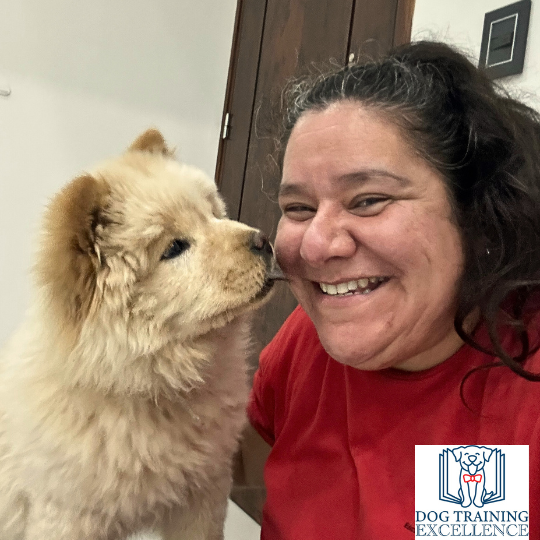
Moony is a 3- month old Chow Chow mix puppy, her
family called me because Moony had already bitten everyone in the
house, except the baby. But they were afraid of things escalating and
the baby getting hurt too.
They adopted Monny from a neighbor who raised Chow-Chows. She told them that they had to establish dominance because "this breed" is stubborn. The vet and other people told them the same thing. So, they didn't let her on the furniture, they put their hands on her plate while she was eating (which cause everyone who did it to get bitten) and punished her for every "bad" behavior.
When I met Moony, she barked at me from the front door and was terrified of me. She did not approach me for the first hour of the class, and later just to grab food I was tossing on the floor. She was terrified of strange people, very stressed and would bark at any stranger.
Solution:
I told the family to STOP putting their hands inside her bowl, stop
punishing her and started basic training (basic commands, socialization
and enrichment). Every new person that came into the house had to toss treats at her and let her approach at her own pace. After 4 classes, Moony was not showing any aggressive
behavior towards anyone in the household, even if they approached her
bowl. She warmed up to strangers very fast and enjoyed life again (you
can see she accepted me happily in the end). We didn't even need to work on desensitization and counter-conditioning.
Moral of the case study:
Do not engage in confrontations with your dog, do not punish your dog,
give your dog what he/she needs to feel safe and satisfied. That simple. This was a puppy case, and that is why Moony learned so fast, if you have an adult dog...then let's continue...
Step-by-step Treatment for Fear Barking
To solve a fear barking dog problem, we combine desensitization and counter-conditioning during training sessions. Here is a step by step example of what to do if your canine is fearful of strangers (switch the word "strangers" for whatever it is your dog is scared of and it works the same way):
Step 1: Keep a log
Buy a cheap notebook and keep a log of each session, this will help you see the progress even if it is minimal. It will also remind you were you left off the last training session. This is important because you DO NOT want to go too fast.
Write down the date, time and subject used for training (i.e., who was helping you as the stranger or if the person used costumes). Write down how your pet reacted the first trial and how he reacted the last trial during the same session.
Step 2: Find helpers
Find volunteer helpers. They can be friends or family members to start with, then you will move on to complete strangers as you go on walks with your hound.
Step 3: Dog Peek-A-Boo!
It's time for your pooch to meet the stranger. Start at a safe distance and short periods of time (2-5 sec).
What is a safe distance? If your pet shows ANY signs of fear (barking, growling, freezing or any other type of anxious body language) then you are too close to the strange person. Move further away. If your dog is good, give him that yummy treat! Then move away from view of the stranger and do it again!
It's like playing Peek-A-Boo!
Professional Tip
Give the treat to your pet when he/she sees the scary person, not you. This means you need to pay close attention to your furry friend.
Repeat this until your pet eagerly anticipates seeing the stranger at a
distance. This means that you might be doing this same thing 10-50 times on
day 1, 10-30 times on day 2…whatever it takes to see that tail-wag at the
sight of the far-away stranger!
Professional Tip
The size of the treat must be the size of a pea to avoid over-feeding your dog. You may also need a high value dog treat.
Step 4: Reduce distance
After many repetitions (it can take from several days to weeks depending on the degree of fear your pet has) you will notice that your hound is completely comfortable when a strange person is in sight (at the safe distance).
Now you can move a little closer…BUT CAUTION…do not move too close, you do not want your dog to react fearfully! Move close enough that it is significantly different from what you were doing before, but not so close that you see any signs of fear in your pet.
Now repeat the same thing, give him a treat at the sight of the stranger, leave. Come back and repeat…repeat…repeat.
Step 5: Change outfits
Repeat steps 1-4 until you are side by side with the strange person. This same person could be using different outfits, like a hat one day, a closed umbrella another, etc. But do this only if your dog is OK, no fear reactions.
Step 6: Repeat steps 1-5 with a different person.
Step 7: Repeat steps 1-5 with extending the time your dog sees the stranger.
Step 8: Repeat steps 1-5 with 2 strangers at the same time.
Step 9: Repeat steps 1-5 with a stranger trying to pet your dog. (Only do this if you are sure your pet will not bite).
Step 10: You can add as many variables as you need, depending on what your dog
is afraid of. Be as creative as you can and always move slowly. Throughout this whole thing your dog should
NOT feel stressed or bark.
By solving your barking dog problem with this methods, you are getting
him used to strangers and also rewarding quiet behaviors.
The number of steps it will take to solve a barking dog problem depends on how fearful your pet is. It also depends on what he fears. For example, if your dog is scared of other dogs, once you reach the point at which you are side by side, you might want to add steps to help him interact and play with the dog. To do this just wait to give him the reward until you see a positive response, like a calming signal or him trying to sniff the other dog in a friendly manner.
Tips to solve a fear barking dog problem
- Before and during the systematic desensitization and counterconditioning program make sure your dog has very little chances of encountering the object of his fear. This will decrease his stress levels and training to solve a barking dog problem will go a lot smoother.
- When your dog shows fear to something, like a loud sound, do not over react yourself! Keep calm and completely ignore the noise (or object) as if it is something of no importance. Then calmly remove your pet from the situation.
- You can act as a safe wall between your dog and the scary object. For example, if your hound is afraid of kids and one of them runs towards your dog while on a walk, physically put yourself between the kid and your dog. Stop the kid and kindly ask him to not bother the dog. Do this calmly and confidently. This shows your pet that you are a good leader that takes care of his pack and will help him feel secure.
- You can use a RED bandana around your hounds neck to signal to other dog owners that your pet needs space and they shouldn't come to close.
- Do not put your pooch in a scary situation. Never force your pet to interact with something he doesn't want to until you have done the proper training to solve this barking dog problem (then you won't have to force him!). If you must, cross the street to avoid undesirable encounters.
- Try Clicker Training! The sound of the clicker is very distinct and helps fearful hounds be more attentive to training. It can also speed up learning and solve your barking dog problem faster.
Best Dog Books For Reactive Dogs
These two books are the latest and most trusted books I can recommend to you, you will learn so much to help your fearful dog and stop dog barking. I did read them both, and I think they are excellent! I also think they are a good pair of books to have, because although they are both about positive reinforcement training, they have two different approaches that you can easily mix and match.
The New Click to Calm: Solutions for All Dogs in a Challenging WorldThe New Click to Calm by Emma Parsons is an excellence book with complete information to help you start your journey of recovery. The book has a strong emphasis on clicker training but will lead you from beginners exercises to more advanced. |
Control Unleashed
|
Frequently Asked Questions About Fear Barking
Is alert barking the same as fear barking?
Is alert barking the same as fear barking?
No. Alert barking is your dog letting you know there is a stranger (or what he perceives as something that needs your attention) and is letting you know. For example, my dogs bark when someone walks outside the house, they stay near the fence barking (probably territorial). But, when y next-door neighbor (who they know and love) comes to tell me something, they bark to alert me someone is at the door (they do this with delivery trucks too), they run back and forth between the gate and my house's door trying to get my attention. Not all dog's will run back and forth, so if yours just stays at the door barking it's OK. Here is how you can reduce alert barking.
Fear barking is accompanied with fearful or threatening body signals in your dog. A dog barking in fear thinks he needs to escape or defend itself and solving this barking problem takes a more detailed training program.
Should I punish my dog for barking?
Should I punish my dog for barking?
Never! No matter what type of barking, you never punish your dog. This is because barking in dogs usually is the results of stress, fear, frustration, boredom...al negative internal states. If you punish your dog, you will only increase these negative feelings. Instead, figure out why your dog is barking and apply the correct solution. You can find all the types of barking and their solutions here.
Why is my dog so terrified of everything?
Why is my dog so terrified of everything?
There are several reasons your dog may be afraid of a lot of things, it can also be a miz of these reasons:
- Genetic predisposition
- Stressful puppy-hood (separated from mom too early, had a stressed mom, etc.)
- Lack of proper socialization
- Traumatic event or events in the past
- Learned and/or generalized fear
- Stress and anxiety due to being constantly punished
- Stress and anxiety due to being in constant stressful situations
- Basic needs not being met (exercise, nutrition, sleep and mental health)
- Disease or chronic pain
How to stop barking in seconds?
How to stop barking in seconds?
Never use punishment to stop dog barking, this will make the problem even worse with time. The fastest way to try to make a dog stop barking is to offer him food, something really yummy the dog can't resist. This may or may not work, and will defenitely won't work long term if there is a true barking problem. You can teach your dog the "quiet" command or follow a personalized training program for long-term results solving a barking dog problem.
Does ignoring dog barking work?
Does ignoring dog barking work?
In most cases this strategy won't work. The only time this strategy may work is if the dog has learned to bark to get attention, in which case ignoring the dog may decrease the problem. However, even in this case, the dog is trying to get your attention for a reason (he needs something: exercise, food, mental stimulation, etc.). If you ignore your dog's needs, barking will resume or your dog may find another annoying behavior to get your attention.
Ignoring a dog barking in fear will NOT work at all.
solve a Fear barking dog problem and Enjoy your Dog
You can use the above methods no matter what it is your dog fears, it works the same way. Examples of fear in dogs are:
- Fear of other dogs
- Fear of other animals (horses, cats, etc.)
- Fear of Strangers
- Fear of Loud noises (gunfire, fireworks, etc)
- Fear of being restrained (i.e. on a leash, with no way out)
- Fear of people or other dogs approaching suddenly or in a threatening manner
- Fear of strange objects (bicycles, crouches, wheelchairs, etc.)
- Fear of nail clipping or other grooming
- and many more!
No matter what your pet is afraid of, the method you should follow to solve a fear barking dog problem is the same:
- De-stress your pet
- Use systematic desensitization and counter-conditioning to change your dog's feelings from fear to Joy.
- Do not use any aversive-based method with your fearful dog.
Want to share your story with the world? Submit your dog's story to help other pet parents with similar problems.
You must describe your situation with at least 150 words and must upload a picture of your dog..
Was this article helpful?
2 ways to help me continue writing professional training content
|
I am a Certified Professional Dog Trainer with more than 15 years of experience. You can hire my services through my Online Dog Training Academy.
|
For as little as $1 a month you can be my Patron and get exclusive benefits while helping me to continue to create the best and most updated content about dog training and positive methods. Be a modern philanthropist through Patreon.com |
This article was written by Natalia Rozas, Ph.D. and Certified Professional Dog Trainer (CPDT-KA #4071465) and updated on on March 30th, 2024. The case studies and anecdotes are real but to protect the privacy of our clients the names and details are changed.
- Home
- Dog Barking
- Barking Dog Problem
